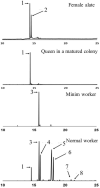Chemistry and Functions of Imported Fire Ant Venom
- PMID: 37624246
- PMCID: PMC10467070
- DOI: 10.3390/toxins15080489
Chemistry and Functions of Imported Fire Ant Venom
Abstract
In the United States, imported fire ants are often referred to as red imported fire ants, Solenopsis invicta Buren, black imported fire ants, S. richteri Forel, and their hybrid (S. invicta × S. richteri). Due to their aggressive stings and toxic venom, imported fire ants pose a significant threat to public health, agriculture, and ecosystem health. However, venom plays a vital role in the survival of fire ants by serving various crucial functions in defense, foraging, and colony health maintenance. Numerous reviews and book chapters have been published on fire ant venom. Due to its medical importance and the expanding global distribution of these ants, fire ant venom research remains an active and highly productive area, leading to the discovery of new components and functions. This review summarizes the recent advances in our understanding of fire ant venom chemistry and its functions within fire ant colonies.
Keywords: chemical communication; defensive compounds; external disinfectant; internal antibiotics; predatory toxins; venom alkaloids; venom proteins.
Conflict of interest statement
The authors declare no conflict of interest.
Figures


Similar articles
-
Pyridine Alkaloids in the Venom of Imported Fire Ants.J Agric Food Chem. 2019 Oct 16;67(41):11388-11395. doi: 10.1021/acs.jafc.9b03631. Epub 2019 Oct 7. J Agric Food Chem. 2019. PMID: 31536348
-
Similarity in venom alkaloid chemistry of alate queens of imported fire ants: implication for hybridization between Solenopsis richteri and S. invicta in the Southern United States.Chem Biodivers. 2012 Apr;9(4):702-13. doi: 10.1002/cbdv.201100109. Chem Biodivers. 2012. PMID: 22492489
-
Fatal anaphylaxis to indoor native fire ant stings in an infant.Am J Forensic Med Pathol. 2008 Mar;29(1):62-3. doi: 10.1097/PAF.0b013e3181651b53. Am J Forensic Med Pathol. 2008. PMID: 19749619
-
Reduction of venom alkaloids in Solenopsis richteri×Solenopsis invicta hybrid: an attempt to identify new alkaloidal components.J Agric Food Chem. 2010 Nov 24;58(22):11534-42. doi: 10.1021/jf103402f. Epub 2010 Oct 21. J Agric Food Chem. 2010. PMID: 20964344 Review.
-
Hypersensitivity to fire ant venom.Ann Allergy Asthma Immunol. 1996 Aug;77(2):87-95; quiz 96-9. doi: 10.1016/S1081-1206(10)63493-X. Ann Allergy Asthma Immunol. 1996. PMID: 8760773 Review.
Cited by
-
Therapeutic Potential of Solenopsis invicta Venom: A Scoping Review of Its Bioactive Molecules, Biological Aspects, and Health Applications.Biomolecules. 2024 Nov 24;14(12):1499. doi: 10.3390/biom14121499. Biomolecules. 2024. PMID: 39766206 Free PMC article.
-
Spider and Wasp Acylpolyamines: Venom Components and Versatile Pharmacological Leads, Probes, and Insecticidal Agents.Toxins (Basel). 2024 May 21;16(6):234. doi: 10.3390/toxins16060234. Toxins (Basel). 2024. PMID: 38922129 Free PMC article. Review.
References
-
- Tschinkel W.R. The Fire Ants. Harvard University Press; Cambridge, MA, USA: 2006. p. 747.
-
- Callcott A.M.A., Collins H.L. Invasion and range expansion of red imported fire ant (Hymenoptera: Formicidae) in North America from 1918–1995. Florida Entomol. 1996;79:240–251. doi: 10.2307/3495821. - DOI
-
- Bertagnolli V., Graham L.C., Vander Meer R.K., Ward K.E., Ward R.N. OUCH! Who bit me?—IFA in Alabama; Proceedings of the Annual Imported Fire Ant Conference; Gainesville, FL, USA. 24–25 April 2007; pp. 112–115.
Publication types
MeSH terms
Substances
LinkOut - more resources
Full Text Sources

